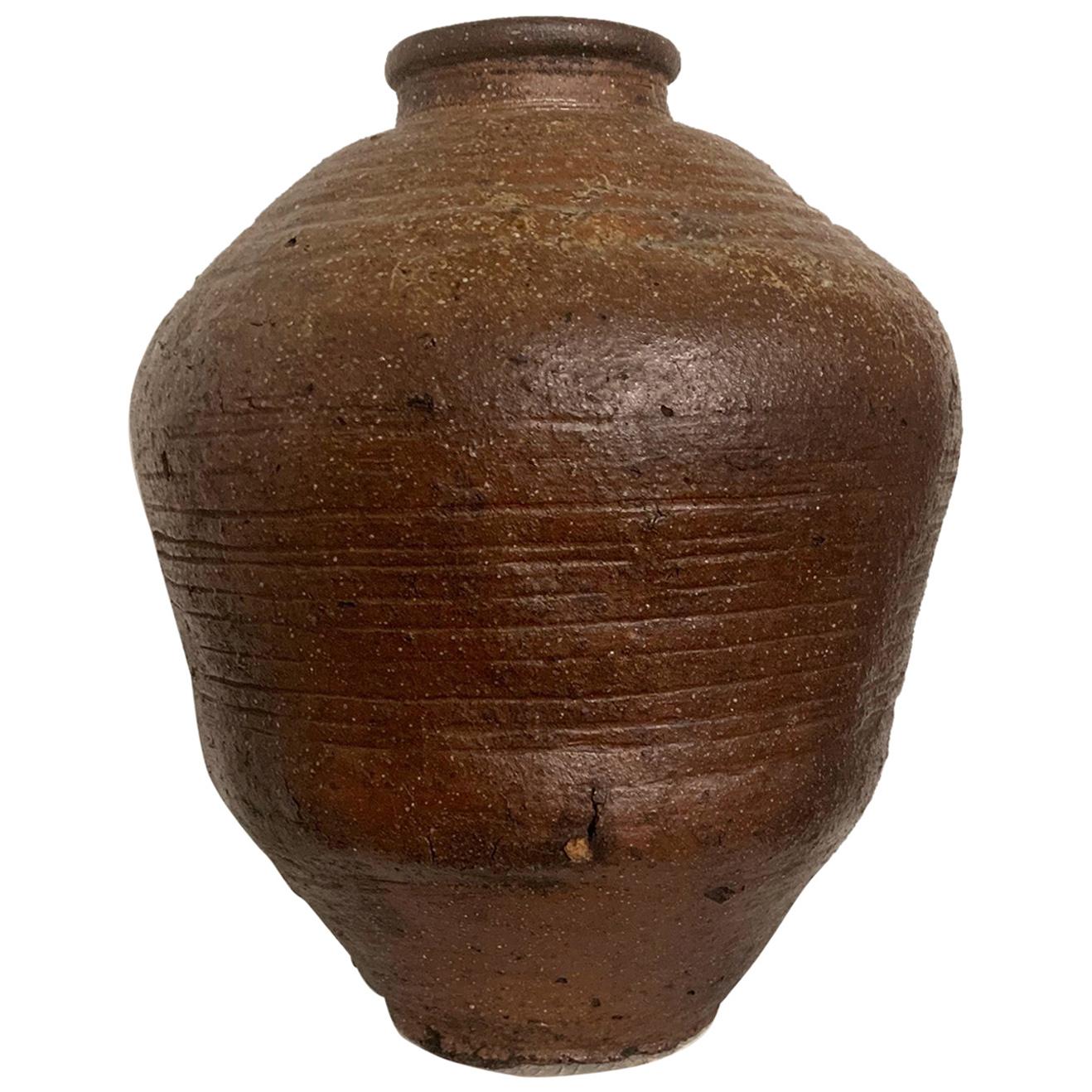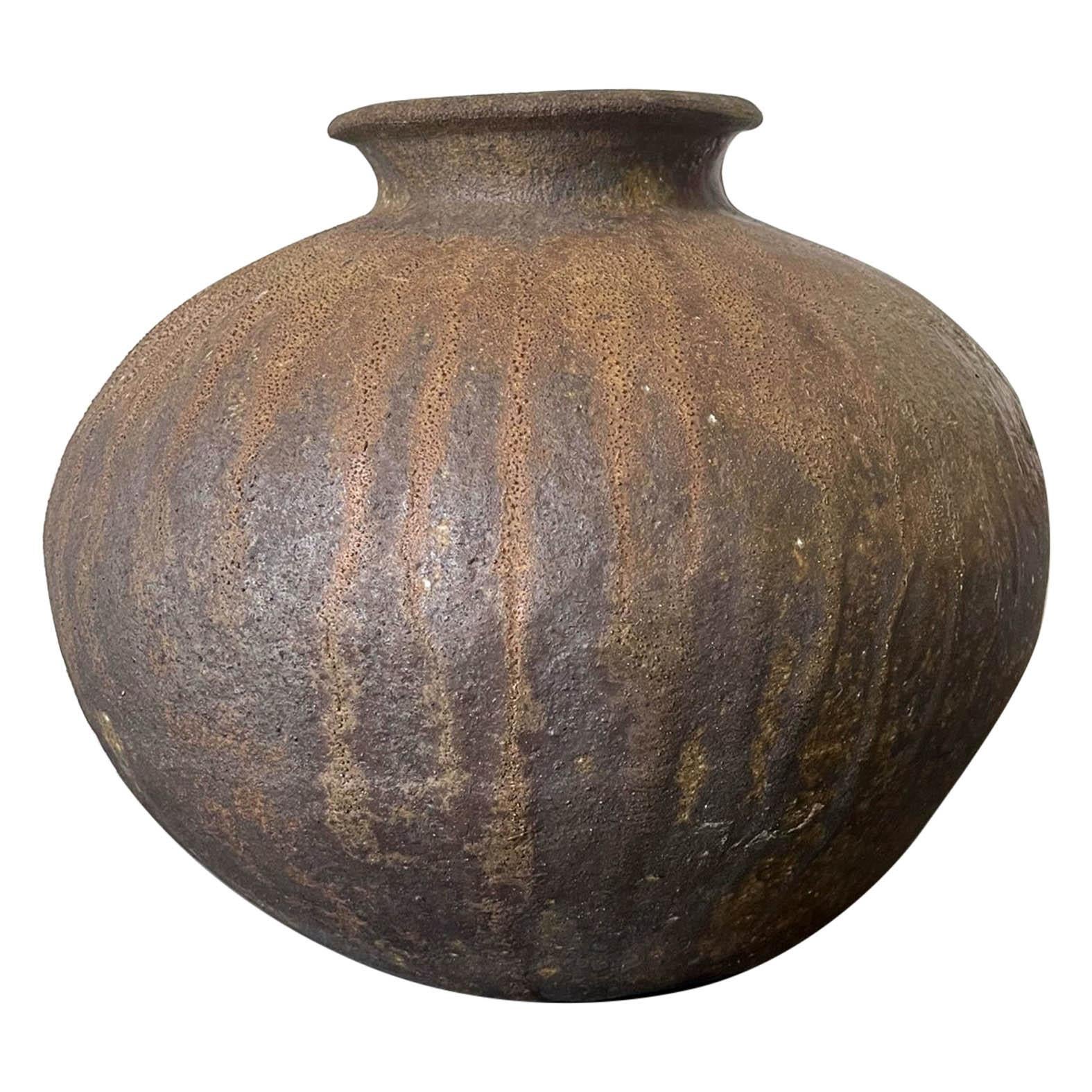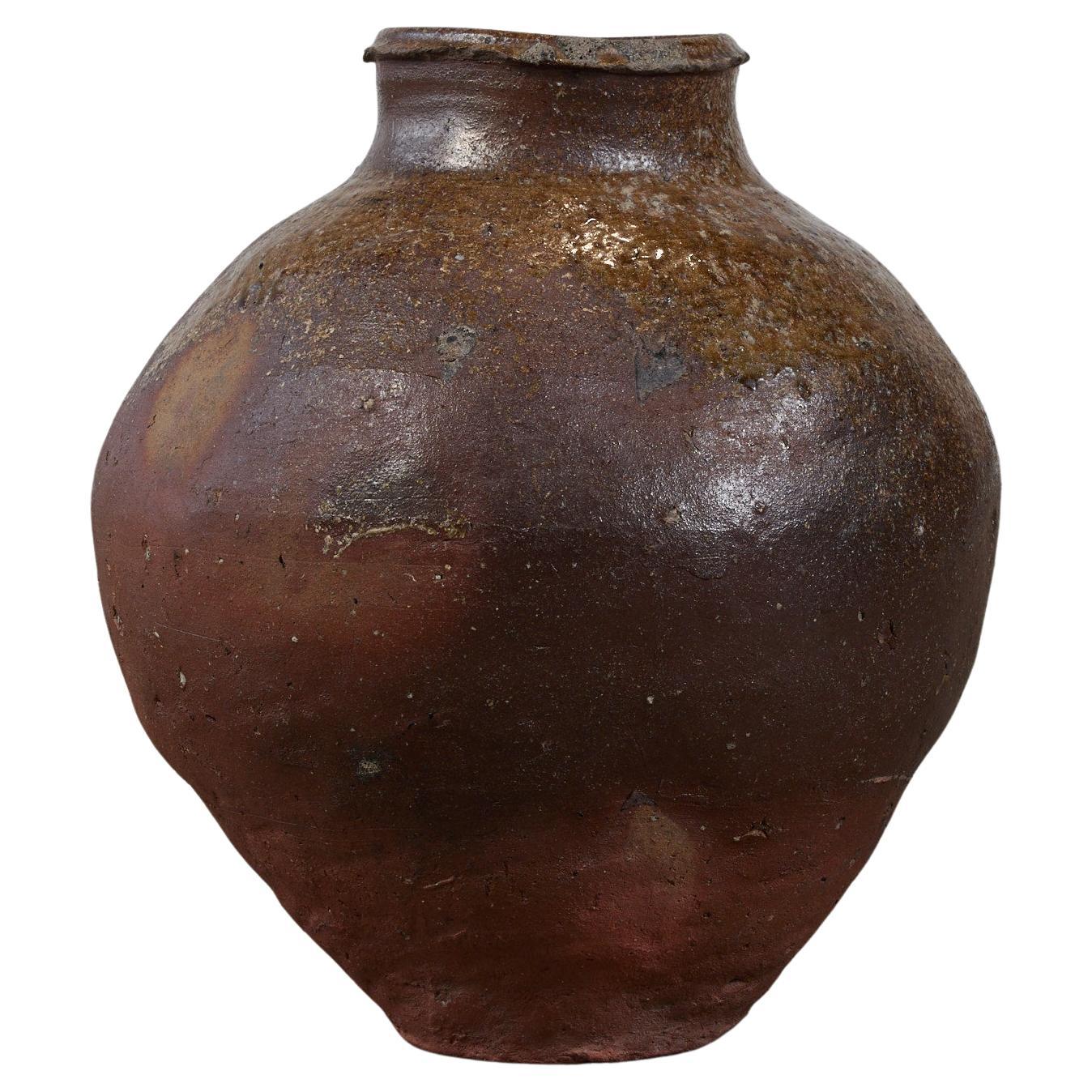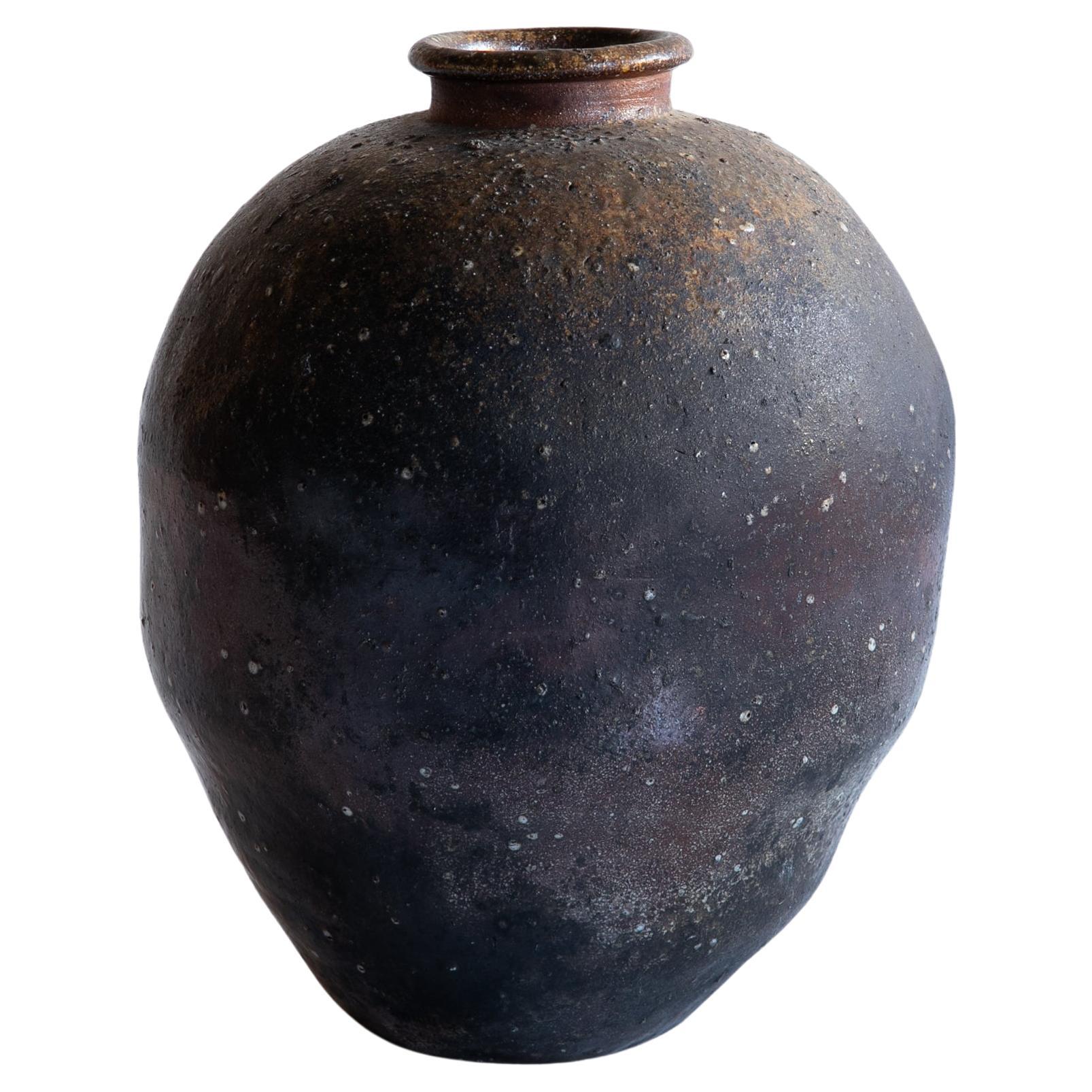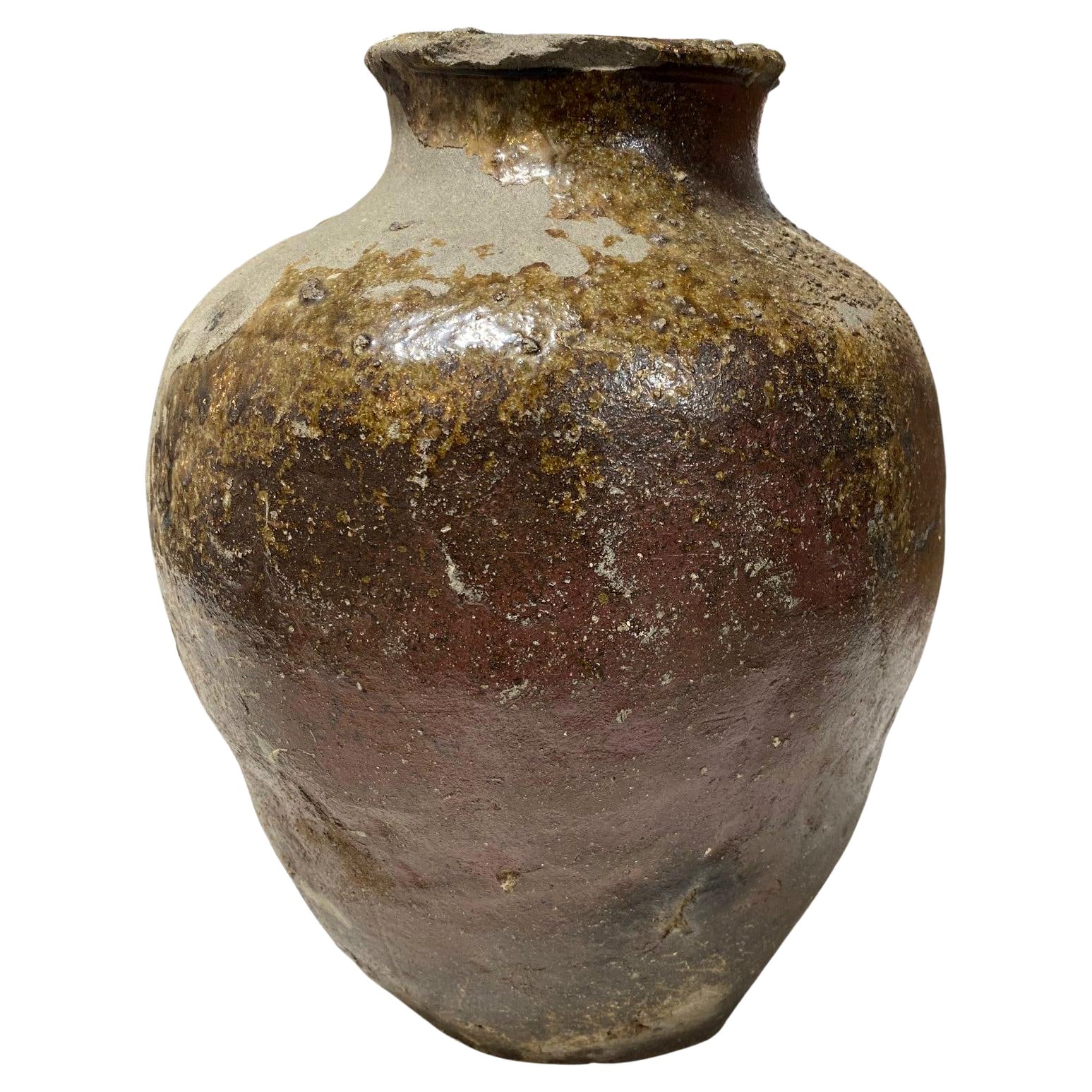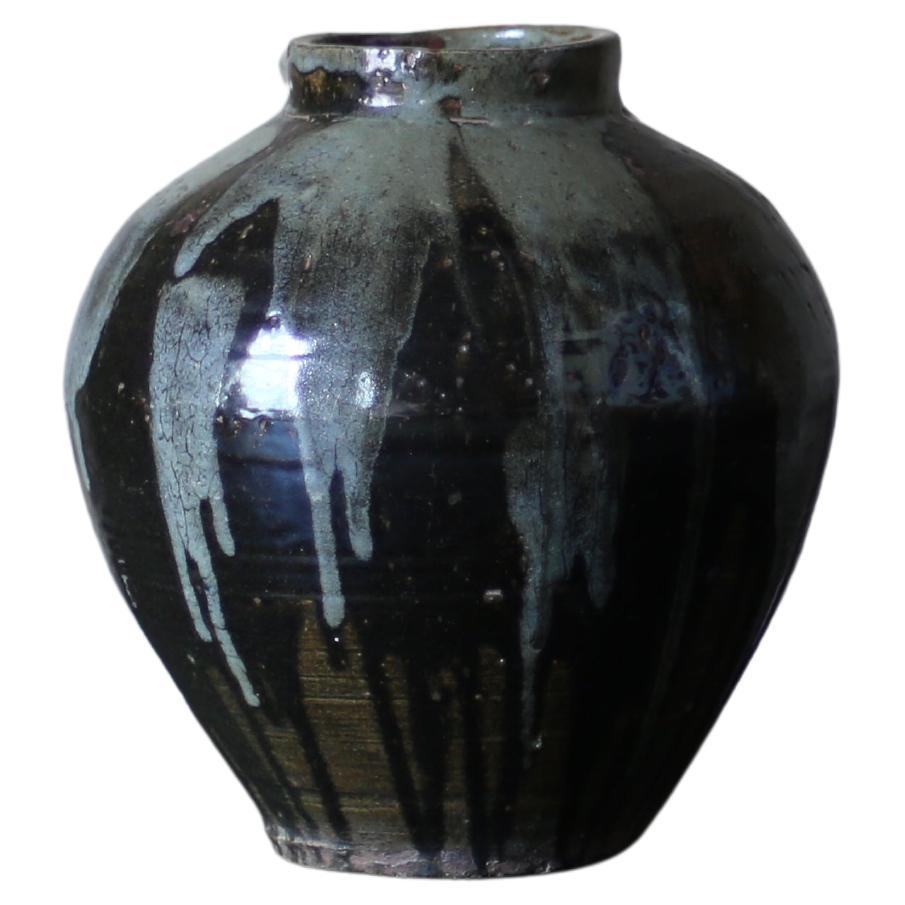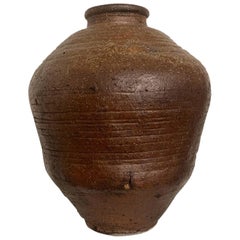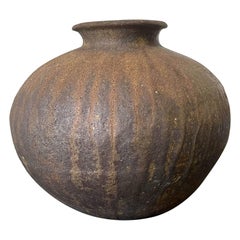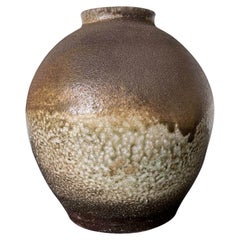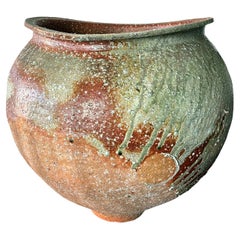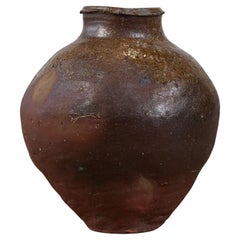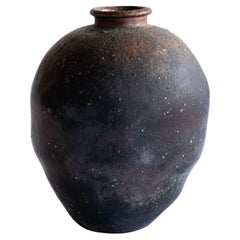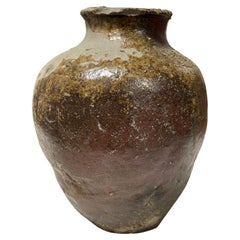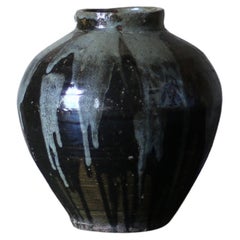Items Similar to Large Ceremic Shigaraki Tsubo by Nagaoka Masami
Want more images or videos?
Request additional images or videos from the seller
1 of 21
Large Ceremic Shigaraki Tsubo by Nagaoka Masami
$7,600
£5,766.71
€6,593.71
CA$10,615.14
A$11,802.59
CHF 6,162.66
MX$143,666.27
NOK 78,632.88
SEK 73,675.25
DKK 49,210.08
Shipping
Retrieving quote...The 1stDibs Promise:
Authenticity Guarantee,
Money-Back Guarantee,
24-Hour Cancellation
About the Item
An impressive Shigaraki Tsubo (jar normally for storage) in an archaic form with a bulbous and robust body that opens with a small lipped mouth. Heavily potted with substantial size and volume, this tsubo showcases an exquisite surface with dripping yellow ash glaze and darker splashed markings in patches, among other kiln firing features. The jar is a work of art from controlled accidents. The glaze drips down and manifests its colors from yellow to ochre and even to a tint of green. It mingles with the volcanic black patches. This Zen-like abstract pattern further contrasts with the beige clay with an unexpected but beautifully integrated red area. The thickly potted lip was hand cut and shaped in irregularity, an intention by the artist to create the wabi-sabi aesthetic. The exterior circle was marked with rustic geometrical patterns, which further enhances its Mingei beauty.
Masami Nagaoka (1948-2013) is a Japanese potter from Izu. Nagaoka began his study in Chiba prefecture with Kamiya Norio and set up his kiln and workshop later in Izu. He used the best clay called "kinose" to make Shigaraki ware. His work shows the distinguished characteristics of natural ash glaze (shizen-yu) and clay flavor (tsuji aji). The occasional lighter green ash color (known as "hipari dashi") was achieved by pulling the piece out of the kiln at the height of firing. This may explains the green tint on this Tsubo.
The piece comes with a wood storage box (tomobako) and a wrapping cloth. The box bears the title outside and his signature and seal inside. It also inscribed "In the mountains of Shuzenji" where the piece was made in his studio. Shuzenji is a town that forms part of Izu.
A humble and quiet potter, he is widely admired in Japan for his work. Two pieces of his ceramic are in the collection of Minneapolis Institute of Art (2013.29.1184 and 2013.29.1242).
- Dimensions:Height: 16 in (40.64 cm)Diameter: 15 in (38.1 cm)
- Style:Modern (Of the Period)
- Materials and Techniques:
- Place of Origin:
- Period:
- Date of Manufacture:2000s-2010s
- Condition:Wear consistent with age and use. Fine condition with surface intended. Box with only minor wear.
- Seller Location:Atlanta, GA
- Reference Number:1stDibs: LU945024688312
About the Seller
4.9
Platinum Seller
Premium sellers with a 4.7+ rating and 24-hour response times
Established in 2006
1stDibs seller since 2010
564 sales on 1stDibs
Typical response time: <1 hour
- ShippingRetrieving quote...Shipping from: Atlanta, GA
- Return Policy
Authenticity Guarantee
In the unlikely event there’s an issue with an item’s authenticity, contact us within 1 year for a full refund. DetailsMoney-Back Guarantee
If your item is not as described, is damaged in transit, or does not arrive, contact us within 7 days for a full refund. Details24-Hour Cancellation
You have a 24-hour grace period in which to reconsider your purchase, with no questions asked.Vetted Professional Sellers
Our world-class sellers must adhere to strict standards for service and quality, maintaining the integrity of our listings.Price-Match Guarantee
If you find that a seller listed the same item for a lower price elsewhere, we’ll match it.Trusted Global Delivery
Our best-in-class carrier network provides specialized shipping options worldwide, including custom delivery.More From This Seller
View AllLarge Japanese Antique Shigaraki Tsubo Jar
Located in Atlanta, GA
An antique Japanese stoneware storage jar, known as tsubo from Shigaraki kiln, circa 17th-18th century (early Edo possibly Momoyama period)....
Category
Antique 17th Century Japanese Japonisme Ceramics
Materials
Ceramic
Japanese Echizen Ceramic Tsubo Fujita Jurouemon VIII
Located in Atlanta, GA
A Japanese storage jar (tsubo) made in the ancient Echizen ware tradition by Fujita Jurouemon VIII. Echizen is one of the six ancient kilns in Japan, directly influenced by the Sue ware...
Category
20th Century Japanese Modern Ceramics
Materials
Ceramic
Japanese Shigaraki Jar for Ikebana by Shiho Kanzaki
By Shiho Kanzaki
Located in Atlanta, GA
A Shigaraki stoneware jar by Japanese potter Shino Kanzaki (1942-2018). Kanzaki is a world renowned potter in Shigaraki who based his modern work on the ancient tradition of Shigaraki and Iga ware...
Category
20th Century Japanese Modern Ceramics
Materials
Ceramic
Large Contemporary Ceramic Tsubo Jar by Kai Tsujimura
Located in Atlanta, GA
A massive stoneware tsubo floor jar created by Japanese contemporary ceramic artist Kai Tsujimura (1976-). The heavy jar with its impressive volume was made in the tradition of Iga ware with local coarse sandy clay that turned reddish after the firing. It took its shape from heavy medieval storage jars with a wide-open mouth. For a nearly identical form, see an Echizen jar from Heian period (794–1185) in the collection of MET (Accession Number: 1977.261). The surface showcases scattered white crystalized feldspars and a green vitrified ash glaze cascade down the body (known as biidoro in Japanese - after the Portuguese word for glass vidoro). These is a globular shape impressed on the jar. It is a signature practice of the Tsujimura potter family by stacking bowls between the pieces in the kiln during the firing, resulting in an accidental but iconic aethetic (Kai and Yui Tsujimura...
Category
2010s Japanese Organic Modern Ceramics
Materials
Stoneware
Japanese Ceramic Seto Tea Leaf Tsubo Jar Edo Period
Located in Atlanta, GA
A Japanese glazed ceramic jar with a lacquered wood lid circa 19th century of late Edo to early Meiji Period. The stoneware tsubo was used as a storage vessel for produce such as tea...
Category
Antique 19th Century Japanese Edo Ceramics
Materials
Ceramic
Modern Japanese Ceramic Shigaraki Ikebana Vase Takahashi Shunsai
Located in Atlanta, GA
A tall ceramic vase made in the tradition of Shigaraki ware by Japanese potter Takahashi Shunsai (1927-2011), the fourth heir of the famed Rakusai lineage of potters. The vase is heavily potted in the reddish sandy Shigaraki clay. It has a Classic vase form made for Ikebana display. The surface is thickly draped with natural ash glaze that deposited onto the body during the firing process in the kiln. It also features decoration of carved lines. Nuggets of feldspar were incorporated in the clay and exposed onto the surface as crystal like jewels. Substantial and archaic looking, the vase also has a strong modern appeal due to its Mingei styling. It was signed on the base with a pressed seal Shunsai as shown. The vase comes with its original wood storage box (tomobako) with bears the title and signature in Kanji and a seal. It also retains a paperwork noting the artist's biography and practice philosophy in Japanese.
Born in Shigaraki, Shunsai was the second son of renowned potter Takahashi Rakusai...
Category
1990s Japanese Modern Ceramics
Materials
Ceramic
You May Also Like
Shigaraki Tsubo Stoneware Ceramic Vessel
Located in Los Angeles, CA
Japanese ceramic vessel from Shiga, Japan. This piece gains its unique glaze and irregularities from the firing process in which wood is added...
Category
Antique 18th Century Japanese Edo Vases
Materials
Ceramic
Japanese Antique Pottery Jar 15th-16th Century/ Wabi-Sabi Vase/Shigaraki
Located in Sammu-shi, Chiba
I would like to introduce an attractive pot that gives you a sense of wabi-sabi.
It is "Shigaraki ware".
Shigaraki is a historical kiln located in Shiga Prefecture, Japan.
It is sa...
Category
Antique 15th Century and Earlier Japanese Edo Vases
Materials
Pottery
Japanese Antique Muromachi Edo Wabi-Sabi Tokoname Art Pottery Jar Tsubo Pot Vase
Located in Studio City, CA
An absolutely stunning Tokoname ware stoneware vase/jar/vessel - produced sometime during the late Muromachi period (1336-1573 to early Edo Period (1603-1867). Tokoname-yaki ware is ...
Category
Antique 16th Century Japanese Edo Ceramics
Materials
Pottery, Stoneware
Japanese Antique Pottery Vase 1900s-1940s / Kasama
Located in Sammu-shi, Chiba
This ceramic vase was made in Kasama, Japan. Kasama is a traditional and famous pottery producing area.
It is very old vase.
It has a very beautiful light blue glaze and has a wond...
Category
Early 20th Century Japanese Taisho Vases
Materials
Pottery
Japanese Antique Edo Wabi-Sabi Shigaraki Tamba Tanba Art Pottery Jar Tsubo Vase
Located in Studio City, CA
A beautiful Tamba (Tanba) ware (or Sigaraki ware) Japanese pottery vase/jar/pot - produced sometime during the Edo Period (1603-1867). Tamba-yaki ware is a type of Japanese pottery a...
Category
Antique 18th Century Japanese Edo Ceramics
Materials
Pottery, Stoneware
Japanese Antique Momoyama Edo Bizen Ware Pottery Wabi-Sabi Art Tsubo Jar Vase
Located in Studio City, CA
An absolutely stunning Bizen ware stoneware vase/jar/vessel - produced sometime during the late Momoyama period (1568-1600) / Early Edo Period (1603-1867). Bizen yaki...
Category
Antique 16th Century Japanese Edo Ceramics
Materials
Stoneware
More Ways To Browse
Large Asian Jars
Japanese Lighter
Japanese Patches
Japanese Wood Bear
Large Clay Jars
Wabi Sabi Jar
Ceramic Glazed Storage Jar
Drip Jar
Japanese Ceramics Mingei
Japanese Storage Jar
Japanese Tsubo
Shigaraki Jar
Tsubo Jar
Shigaraki Tsubo
Nagaoka Masami
Qing Famille Rose
Famille Rose Export Porcelain
Hand Painted Lotus
